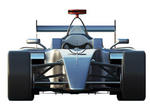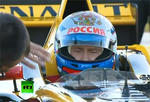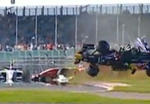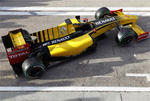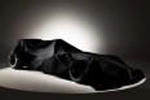
The ING Renault F1 Team has released today the images and details of the Renault F1 R29 race car which will compete in the 2009 Formula One season. The Renault F1 R29 is powered by a 2.4 liter V8 engine, that's able to get to a maximum speed of 18,000 rpm, and is based on a carbon fiber and aluminum honeycomb composite monocoque.
The Renault F1 R29 has been developed having in mind the reduction of the weight as much as possible in order to fit it with the KERS system.
The aerodynamics of the Renault F1 R29 feature a wide front wing fitted with a driver controlled adjustable incidence flap. the front end of the Renault F1 R29 also features a revised suspension layout with new geometry including inclined wishbones and a higher monocoque.
from the Renault press release:
Renault F1 R29 Technical Description
Following the ING Renault F1 Team’s improving performance in 2008, the new R29 is a development in design philosophy aimed at extracting maximum performance from the new aero regulations, slick Bridgestone tires, and KERS system, whilst further developing the strong features of the R28.


With such radical rules coming into force, particularly with respect to aerodynamics, the team placed great emphasis on maximizing the R29’s time in the wind tunnel, with aero development already underway by February 2008. CFD has also played a considerable role in the design of the car and has been particularly valuable in understanding the interaction of the aerodynamic package as a whole. There has been a concerted effort to save as much weight as possible on the R29 to allow for the introduction of the KERS system. As a result, the design team has moved towards using alternative materials and construction methods, such as the carbon-titanium gearbox casing, increased use of MMC aluminum and magnesium.
Renault started the design work of the KERS system in 2007 in conjunction with Magnetti-Marelli. The system consists of a motor-generator, which is connected to the front of the engine (this charges the battery on braking and releases the energy under acceleration), a battery pack located in the chassis and a KERS control unit.
The front end of the car is dominated by the 2009 aero specification wide front wing which has a driver controlled adjustable incidence flap. This looks very different to previous years being much
closer to the ground and has much greater influence on the air flow over the tires due to its increased span. Great attention has therefore been paid to the end plates which have become much more critical devices than they have been in previous years. The front end also has a more radical front suspension layout with new geometry including inclined wishbones and higher monocoque in order to maximize the new slick tires and improve aerodynamic efficiency.
The rear of the monocoque under the bodywork has changed considerably with the integration of the
KERS system, which has taken a lot of effort to package neatly for the minimum weight. The
introduction of this new technology has also influenced the car’s aero package with carefulconsideration paid to ensure sufficient cooling.
The bodywork appendages, such as winglets, flicks and chimneys have now largely disappeared with
the 2009 aero regulations. The surfaces are therefore much simpler and more streamlined, although the
R29 still incorporates the R28-type dorsal fin and flush exhaust exits seen on previous Renault F1 cars.
The 2009 rear wing is narrower and higher and reverts back to the centrally-supported single pylon
design first introduced on the R26.
The four-race gearbox has a brand new carbon-titanium main case to save weight, and an improved
gearshift system developed on the R28, which has also reduced weight and improves performance.
The R29 therefore shares little in common with its predecessor with much of the car designed from a
clean sheet of paper. This is particularly true of the aerodynamic package where efforts in the past have
concentrated on evolutionary design. The technical team has risen to the challenges of this shake-up in
the rules and looks forward to seeing the results of their efforts on the racetrack when the R29 makes
its debut this January.
Renault F1 R29 Technical Specifications
Chassis
Molded carbon fiber and aluminum honeycomb composite monocoque, manufactured by the Renault
F1 Team and designed for maximum strength with minimum weight. RS27 V8 engine installed as a
fully-stressed member.
Front suspension
Carbon fiber top and bottom wishbones operate an inboard rocker via a pushrod system. This is
connected to a torsion bar and damper units which are mounted inside the front of the monocoque.
MMC aluminum uprights and machined magnesium wheels.
Rear suspension
Carbon fiber top and bottom wishbones operating angled torsion bars and transverse-mounted damper
units mounted on the top of the gearbox casing. MMC aluminum uprights and machined magnesium
wheels.
Transmission
Seven-speed semi-automatic carbon-titanium gearbox with reverse gear. “Quickshift” system in
operation to maximize speed of gearshifts.
Fuel system
Kevlar-reinforced rubber fuel cell by ATL.
KERS
Motor generator unit driving into front of engine with batteries as an energy store.
Cooling system
Separate oil and water radiators located in the car's sidepods and cooled using airflow from the car's
forward motion
Electrical
MES-Microsoft Standard Electronic Control Unit.
Magnetti-Marelli KERS control unit.
Braking system
Carbon discs and pads (Hitco); calipers and mastercylinders by AP Racing.
Cockpit
Removable driver’s seat made of anatomically formed carbon composite, with six-point harness seat
belt. Steering wheel integrates gear change and clutch paddles, front flap adjuster and KERS energy
release controls.
Car dimensions and weight
Front track 1450 mm
Rear track 1400 mm
Overall length 4800 mm
Overall height 950 mm
Overall width 1800 mm
Overall weight 605 kg, with driver, cameras and ballast
Renault F1 RS27 Technical Specifications
Capacity 2400 cc
Architecture 90° V8
Weight 95 kg
Max rpm 18,000 rpm
ECU MES SECU
KERS control Magnetti-Marelli
Fuel Total
Oil Total
Battery Renault F1 Team
Identical specification RS27 engines will be supplied to the ING Renault F1 Team and to Red Bull
Racing for the 2009 season.





